The Acer Swift 3 SF314 Notebook Review: Swift Gets Swifter With Ryzen 4000
by Brett Howse & Andrei Frumusanu on May 5, 2020 8:00 AM ESTGPU Performance
Ever since the original Raven Ridge systems, AMD’s Zen-based APUs have set the bar for GPU performance in a 15-Watt package. Coupling AMD’s Vega GPU cores with their Zen CPU cores really changed the game in terms of integrated GPU performance. Their second-generation Picasso platform even bumped the compute unit count up to 11 with the Ryzen Microsoft Surface Edition processor, which was once again based on Vega.
AMD’s philosophy has changed slightly for their third generation Zen-based APU, Renoir. Thanks to the move to TSMC’s 7 nm process, they decided to cut back the GPU cores, but provide more frequency headroom, and coupled with the CPU performance gains of Zen 2, AMD promised faster GPU performance despite the reduction in compute units. So, for the Ryzen 7 models, they are now offering either seven compute units on the Ryzen 7 4700U we have in our review unit, or eight compute units in the Ryzen 7 4800U, with maximum frequencies of 1600 Mhz and 1750 MHz respectively. That means that the unit we are testing today is down four compute units compared to the Ryzen 7 3780U found in the Surface Laptop 3, and although the maximum boost frequency is higher, it is only 200 MHz higher than the best Picasso APU available. We’ve seen AMD ramp up frequency before to get more performance out of their GPUs, and it has served them well, but in a laptop platform, there is far less thermal room to work with, so we shall see how the new philosophy works out for them.
Our testing philosophy for laptops with integrated GPUs has had to evolve very quickly. Laptops based on Intel’s Gen 9.5 graphics had such poor GPU performance that it was not even worth testing them against most 3D games, but both AMD’s Vega GPU on Ryzen, and Intel’s Iris graphics in their Ice Lake SoC have both moved the bar upwards, so more vigorous testing is now required. As with any new testing we bring, please give us some time to fill in the data as we test new devices.
3DMark


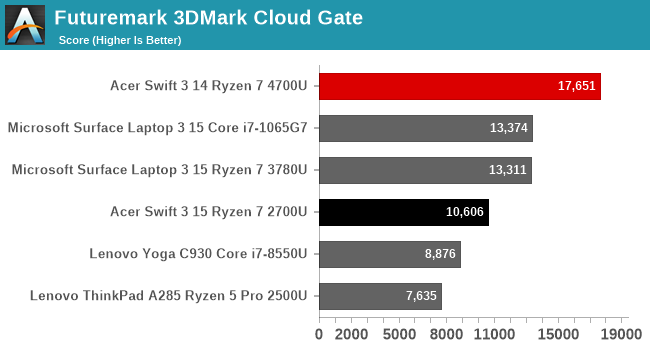
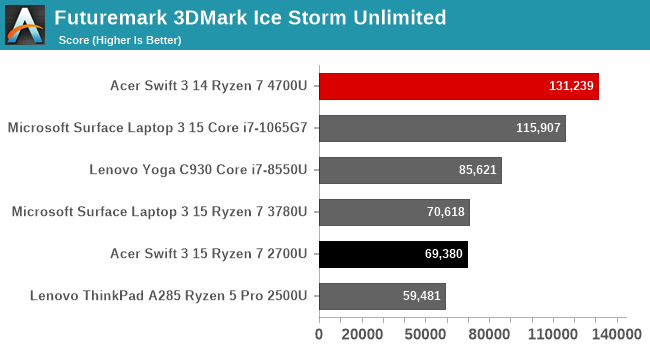
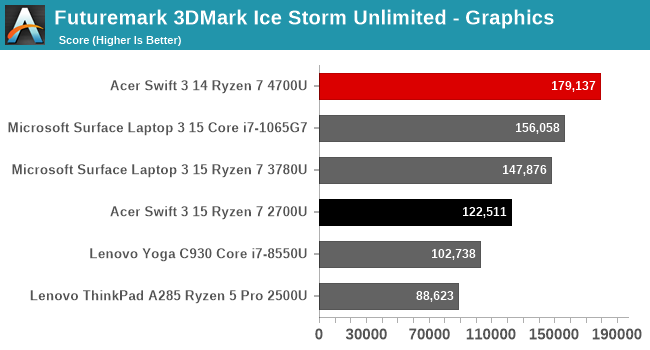
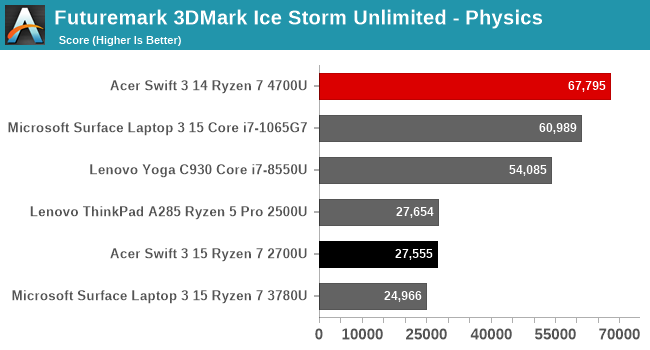
UL’s 3DMark suite offers a range of tests of varying complexity, from the high-end Fire Strike, down to Ice Storm Unlimited, which can be run on smartphones. The Acer Swift 3 is off to a great start with these DX11 based tests, easily outperforming the previous Picasso scores as well as Intel’s Ice Lake platform. The most interesting result is the Ice Storm Unlimited Physics results, where Renoir scores 2.7 times higher than Picasso. The Physics tests are really CPU bound tests, which clearly shows how CPU limited the previous AMD APUs had been.
GFXBench

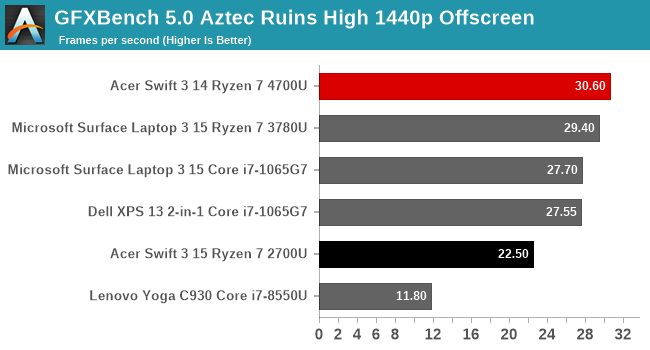
Thanks to the new DX12 tests Kishonti introduced with version 5.0 of their GFXBench suite, this cross-platform benchmark is again relevant on Windows. The results from the Ryzen 7 4700U are interesting. AMD has often done well on DX12, likely thanks to their early efforts with low-level drivers, and their previous Picasso GPU did very well on this benchmark. The Renoir does surpass Picasso, but the margin of victory is small.
Tomb Raider
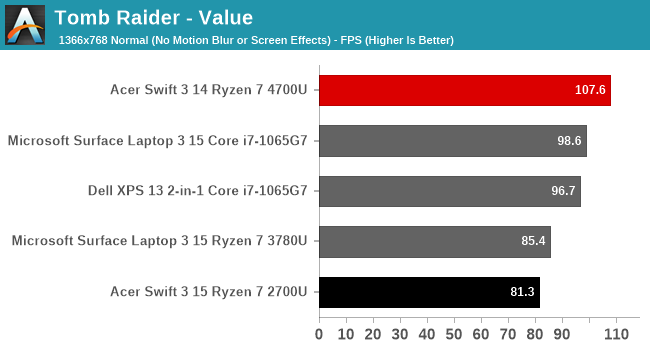
Although a bit long in the tooth, the original Tomb Raider reboot can still be taxing on notebooks, although the game is certainly playable on the modern integrated GPU if you turn down the settings. On our value settings the Acer Swift 3 was able to achieve over 100 frames per second, meaning there is quite a bit of room to increase the quality as long as you keep the resolution down. On both Ice Lake and Renoir, the game is unplayable with our Enthusiast settings at 1920x1080, despite its age.
Rise of the Tomb Raider
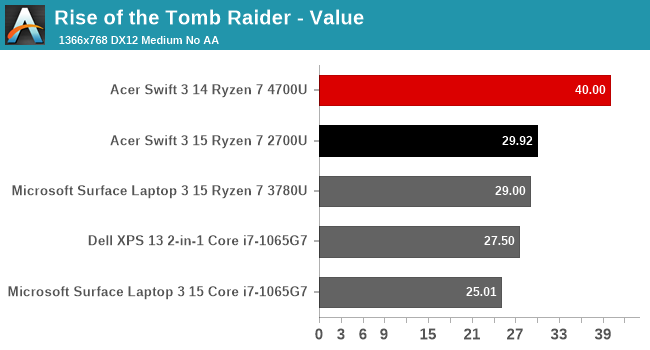
The first sequel to Tomb Raider added DX12 support, and as usual that means our AMD APUs did well. Although the game would be barely playable on Picasso or Ice Lake, the Acer Swift 3 with Ryzen 7 4700U looks like it just squeezes past the 30 FPS minimum you’d really want. This game is still at the limits of integrated GPUs.
Strange Brigade
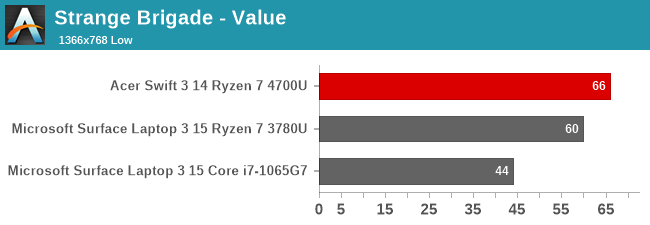
The co-operative third person shooter Strange Brigade is a DX12 title that does well even on integrated GPUs. It also appears to be more CPU bound than some of the other DX12 titles in our list, so the extra performance offered by the Zen 2 cores in the Acer Swift 3 help propel it to the top, with far more performance than the previous generation AMD APU.
F1 2019
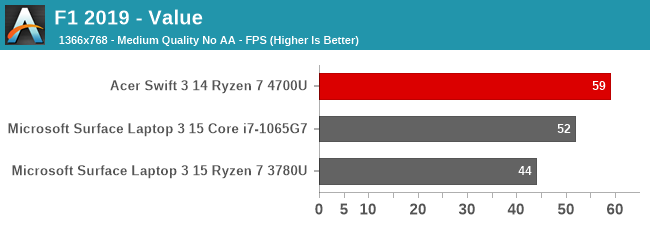
Codemaster’s F1 series is yet another game that can do well even on integrated graphics if you want to turn the settings down. The Acer Swift 3 does very well here, almost achieving an average of 60 frames per second.
Far Cry 5
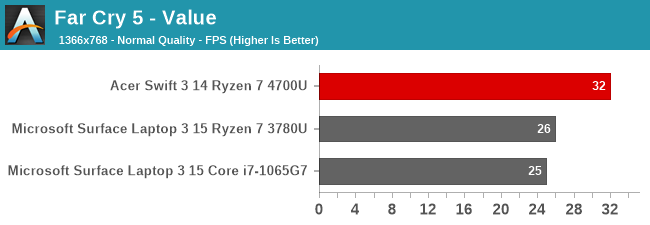
Ubisoft’s Far Cry franchise is well known, but it’s also been impossible to play on most integrated GPUs. That is still the case with the Acer Swift 3, although it just manages over 30 frames per second in this test, outclassing all other integrated notebooks tested. We will get into this a bit later, but this game also showed some very severe thermal throttling, with major dropouts in framerate during the benchmarking.
GPU Results
Although AMD cut back on the size of the GPU in Renoir, they don’t seem to have hurt maximum performance, and the new Zen 2 cores really show that the previous Raven Ridge and Picasso APUs were very CPU bound on some titles. With 36% fewer compute units than the Ryzen 7 3780U found in the Surface Laptop 3, the Acer Swift 3 still manages to outperform it in all cases.
However, the Acer did run into thermal issues when running at maximum performance. Some of this will come down to the cooling system in this particular notebook, but the power management of the Renoir APU also did not seem to be able to cope very well. Rather than find a sweet spot where it can perform well without throttling, the frame rate in Far Cry 5 was like a roller coaster the longer you left the game running. AMD’s choice to cut back on the number of compute units and then increase frequency certainly won’t help here either, and it makes you wonder how well the GPU would have been able to perform on the new 7 nm process with more CUs but a lower maximum boost frequency. We will dig more into the thermals later in the review.










191 Comments
View All Comments
LaMpiR - Friday, May 8, 2020 - link
So, a 649$ laptop costs in Europe 890$. How is this possible?neblogai - Saturday, May 9, 2020 - link
Something was probably wrong with the sample Anandtech got. Here is a video of FarCry5- Swift 3 4700U temps stay at nice and cool ~69C even in the long and action packed scene: https://youtu.be/8A2XFdAZLPQ . There is also another test with a 4500U model from the same channel- no temperature issues there either, nor in any of the ~20 games tested. Other channels, like Dave Lee, also say that cooling is just so capable and quiet, that Acer should have upped cTDP higher.Oxford Guy - Saturday, May 9, 2020 - link
Maybe it's just me, but the whole article seems very deceptive.The headline should be: "The Acer Swift 3 SF314 Notebook Review: Swift Gets Slower With Kneecapped Ryzen 4000"
The little TDP graphic should be 8+ watts, not 15.
neblogai - Sunday, May 10, 2020 - link
It is just you. Acer would not be wrong to call Intel models 'Swift 3', and AMD models - 'Swifter 3'.watzupken - Sunday, May 10, 2020 - link
The throttling is to be expected when you see a 1.2kg laptop. Where can they cut in order to lose few hundred grams, when the battery size is the same? Surely its got to be the cooling solution. If you are looking for performance, these ultra slim laptops are not for you. The same problem plagues Intel based laptops as well. As PC maker/ manufacturers go crazy about cutting weight and size of laptops, a lot of these thin laptops suffer from thermal throttling, poor upgradeability and missing port convenience.In this case, I think there may be something wrong with the fan curve and should be resolved through some software updates. The cooling solution looks normal to me after cracking open a few of these laptops with low power processors. Only observation is that the heatsink is getting thinner over the years, which will certainly impact cooling. Mid end models should have a longer heatsink with slightly bigger fan to cover the longer heatsink, while high end models may end up with dual heatsink and fan cooling solution to get around the slimness.
Oxford Guy - Monday, May 11, 2020 - link
Yes, it's "just me" because apparently 8 watts is "Swifter" than the 15 it's supposed to run at.At least the 15W graphic appears to have been removed. That's something.
Oxford Guy - Monday, May 11, 2020 - link
"The throttling is to be expected when you see a 1.2kg laptop. Where can they cut in order to lose few hundred grams, when the battery size is the same? Surely its got to be the cooling solution. If you are looking for performance, these ultra slim laptops are not for you."I don't buy this excuse.
When a company sells a product it shouldn't be a bait and switch deal.
If Acer wants to post "8+ watts" as the TDP of the CPU in a prominent place that's one thing. If it lists 15W and/or just the CPU model then that's not good enough.
Moreover, it should be made clear to the consumer that the CPU is throttled to get to that 8 watts, not that it's just so efficient it can function at 8 watts to do the equivalent of what should take 15 for the same CPU because of something special about the machine's design.
If the machine can't handle a 15 watt CPU then it should be throttled to what it can handle and that should be the spec sold to consumers, not the spec it can't handle.
ReallyBigMistake - Sunday, May 17, 2020 - link
"Key to this is a much-needed jump from GlobalFoundries' 12nm process to TSMC's class-leading 7nm process"I am calling it but GF days are numbered.
Cirecomputers12 - Sunday, June 7, 2020 - link
What you guys don't get is the internals are great at the price of a very CRAP display. Just look up the srgb and the Adobe rgb its terrible. The brightness nits are 250 which is pretty much as dark as you can go with laptops. SO if the display doesn't mean that much, this an awesome deal. If it does all the power in the world isn't going to make that Display any better. It's also made out of plastic......It's up to you ......AdriaticAdrian2 - Tuesday, April 27, 2021 - link
Does someone know if I charge it with anything lower than 65w through USB-C? I have it but I don't want to buy anything that will not work